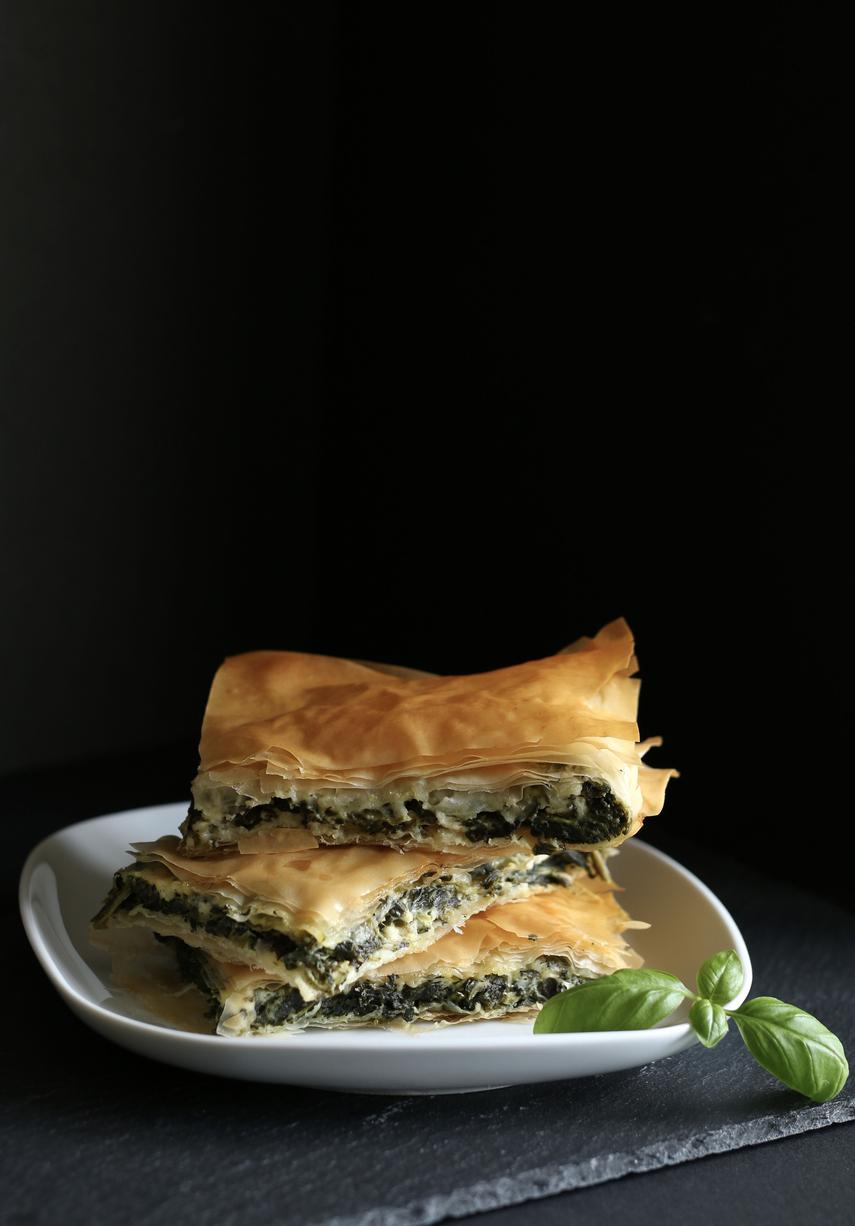
Pies are an integral part of Greek cuisine, with a history dating back millennia. To find out more about the most traditional pies in Greek cuisine and how they best pair with wine, it’s helpful to first look at the role they have played over the years.
Pies first appeared at a time when humans were transitioning from hunter-gatherers to settlement dwellers who started to cultivate crops, primarily grains, which they then turned into flour. By then adding water, they made dough and started using fire to bake it. The first pies were baked directly on the fire, in the form of flatbread. Prehistoric humans added whatever other food was available on top, depending on the season. Later, it is very likely that they baked them on hot stones to make them flat, better control the temperature, and prevent burning. In ancient Greece, there was a form of pie known as “plakountas”or “plakites”. This would later evolve into what is now called a “plakopita”.

It’s during this period that the first ovens also appear, baking the pie from above and below.
Centuries later, nomadic shepherds in Epirus and Macedonia constructed portable, make- shift ovens to bake their pies, which they made with what was at hand: fresh vegetables from the fields, fresh cheese they made themselves, and meat from animals they slaughtered for sustenance. They mixed honey with cheese, a nutritiously satisfying blend.
Today’s Greek pies can be divided into three main categories. There are pies made with thin layers of pastry dough below, above and sometimes in between the pie filling. (These layers are usually brushed with olive oil or butter, so they become crispy and airy during the baking process.) There are pies made with thicker dough that’s folded back on itself to enclose the pie contents. The third category consists of open-faced pies, ones made with dough only on the bottom; they are also known as tarts. For each of these classifications, there are hundreds of variations ranging from vegetable-only to cheese to meat pies. There are sweet pies as well. (It should also be noted that there is, in fact, a fourth kind of pie, one made without any dough at all.)
This rugged land in the northwest of the country is the region of Greece that is most famous for its savory pies.
Τhe cuisine of Crete also features many pies; the most famous of them are the marathopita and the sfakianopita.
[4] MARATHOPITA
To an extent, this pie resembles the batsaria of Epirus. Yeast is used to make its pastry rise, and very often tsikoudia is added as well, resulting in a dough that gets crispy as it bakes in the oven. For this pie, both the leaves and the finely chopped bulb of the maratho (or fennel) plant are used, along with other aromatics. Among locals, it’s often made during periods of partial fasting, as its rich flavor is much appreciated then. The best wine pairing is with the native Cretan variety Dafni, whose wines are characterized by a botanical nature and a lemony aftertaste.
[5] SFAKIAN PIE OR SFAKIANOPITA
The most famous pie of Crete, this treat is madein the pan rather than the oven; fresh cheese, called “tyromalama” and made from the whey that’s removed during the production of graviera cheese, is placed between two thin sheets of dough. (If you can’t source the whey, myzithra or anthotyro are good substitutes.) When the dough has been fried, honey is added, as is, depending on what is available, crushed nuts and a fragrant spice of some kind, usually cinnamon. To go with this treat, try a sweet wine made from Liatiko from Dafnes, which, with its abundant charac- ter of spices and honey, will combine beautifully.
[6] LEEK AND GROUND BEEF PIE
One of my favorite pies, which I always seek out when I go to Xanthi, is the leek and ground beef pie with its airy, buttery pastry and a flavor that combines the sweet and vegetal element of the leeks with the rich taste of chopped beef. This is an excellent pie that pairs nicely with wines from Goumenissa. Their acidity balances the richness of the pie, while the tannins pair with the proteins of the meat and the red fruit gives an additional aromatic dimension.
[7] LADENIA
On the island of Kimolos, you’ll find the equivalent of Italian focaccia, a fluffy and soft dough known as ladenia and used to make an open- faced pie of the same name. This amazing treat is at its best in the summer, when it’s made with garden-fresh ripe tomatoes and onions and baked in a wood-fired oven, to acquire a smoky aromatic character. I really enjoy pairing it with the Aidani of Santorini, with its floral and vegetal character as well as its full body.
Before closing, I must include the Kaisareia pie, or pastourmadopita, with its airy, buttery, and crispy pastry, Greek hard yellow cheese (kasseri or graviera) – amounts added will depend on how salty we want the pie – pastourma (a highly seasoned air-dried cured beef), and plenty of tomato. The acidity of the tomato will balance the richness and the tomato’s sweetness will compensate for the saltiness of the cheese and the pastourma. A pie with great aromatic intensity and full body, the Kaisareia pie needs a wine that’s equal to it. The Nychteri from Santorini is an excellent choice, as it has both the body and the acidity to cope with the intensity of this savory delight.
Με την εγγραφή σας στη λίστα των παραληπτών θα λαμβάνετε το newsletter του grape!





Με την εγγραφή σας στη λίστα των παραληπτών θα λαμβάνετε το newsletter του grape!